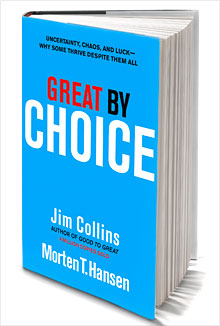Author: Jim Collins and Morten T. Hansen
Publisher: Harper Business – 384 pages
Book Review by: Sonu Chandiram
Jim Collins is the author and co-author of six other business books besides this one, which have collectively sold more than ten million copies. Among them is the bestseller Good to Great published about a decade ago, which by itself has sold more than four million copies so far. Two other bestsellers among the six are Built to Last and How the Mighty Fall. His work experience includes research and being on the faculty at Stanford Graduate School of Business.
Morten T. Hansen is a management professor at the University of California in Berkeley. He was formerly a professor at Harvard Business School. He has a PhD from the Stanford Graduate School of Business. His work background includes being a manager at Boston Consulting Group, teaching and consulting with corporate executives. He is author of the book Collaboration.
In an era when more than 350,000 new titles are published annually competing for readers’ attention, to stand out by writing bestsellers is impressive indeed. I have not yet read Good to Great but if the principles of business success in that book were based on extensive research just as is the case in the current book, then I am not surprised at all that that book was read by millions.
Great by Choice today is No. 258 in Amazon’s ranking of books. Why so, I asked myself? The first observation I made when beginning to browse through this book was that it is based on nine long years of research, with data laid out in more than 55 pages of the book.
The other strong foundation I found for truth in the discussions in this book is that numerous books were consulted as this one was being written. Those works are named in about 40 pages in the Notes section. Together 95 pages of research and notes form nearly one third of the length of this book – 293 pages – excluding the index pages.
Facts gathered from research obviously carry a stronger basis for statements, and they are much more valuable than opinions, no matter how experienced and knowledgeable a writer is. And notes from other books support much of the assertions in this book. So I take serious heed to what the authors advise in this book, as I suggest all readers should, to derive maximum value from it.
The principal question this book answers is: why do some companies thrive in uncertainty, even chaos, and others do not? To answer this question, the authors enlisted more than 20 researchers to study outstanding companies, those who had beaten their competitors by a minimum of 10 times over a 15-year period, in a number of measures.
The research revealed these findings:
“The leaders of the best companies were not more risk taking, more visionary, and more creative than others in the groups studied; they were more disciplined, more empirical, and more paranoid.”
“Innovation by itself turns out not to be the trump card in a chaotic and uncertain world; more important, is the ability to scale innovation, to blend creativity with discipline.
“Following the belief that leading in a ‘fast world’ always requires ‘fast decisions’ and ‘fast action’ is a good way to get killed.”
The great companies changed less in reaction to a radically changing world than the comparison companies.”
Through the book’s seven chapters, the authors look at the stock performance of the outstanding companies (named 10x) during the up-and-down thirty-year period between 1972 and 2002. Over long periods of time, stock price movements are reflective of the key fundamental performance indicators of companies – such as growth of revenues and profits, returns on investments, assets and equity, and other factors.
They look at the characteristics of these great companies that set them apart from the ordinary ones, and give the readers reasons why the financial performances were superior.
I urge readers to find out for themselves what made these stand-out companies not only survive but thrive amidst all the turbulence over the years.







